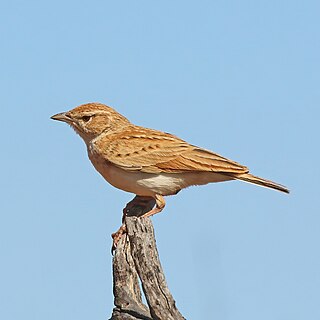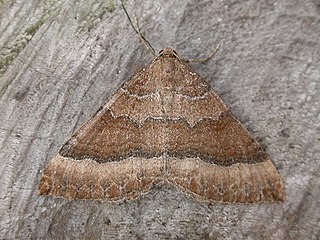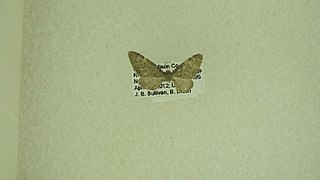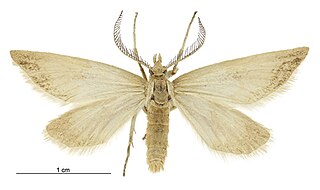
The geometer moths are moths belonging to the family Geometridae of the insect order Lepidoptera, the moths and butterflies. Their scientific name derives from the Ancient Greek geo γεω, and metron μέτρον "measure" in reference to the way their larvae, or inchworms, appear to measure the earth as they move along in a looping fashion. A very large family, it has around 23,000 species of moths described, and over 1400 species from six subfamilies indigenous to North America alone. A well-known member is the peppered moth, Biston betularia, which has been subject of numerous studies in population genetics. Several other geometer moths are notorious pests.

The fawn-coloured lark or fawn-coloured bush-lark is a species of lark in the family Alaudidae. It is found in south-central Africa.

Larentia clavaria, the mallow, is a moth of the family Geometridae. The species was first described by Adrian Hardy Haworth in 1809. It is found from Siberia in the east to the Iberian Peninsula, North Africa, and the British Isles in the west. In the north it ranges to the Caucasus, Tajikistan and Fennoscandia. In the south it is found the western Mediterranean islands, Italy, the Balkans and Asia Minor. It occurs only locally and is almost always rare. In the Alps, it rises up to 1200 m above sea level.

Mesotype didymata, the twin-spot carpet, is a moth of the family Geometridae. The species was first described by Carl Linnaeus in his 1758 10th edition of Systema Naturae. Its genus is sometimes included in Perizoma.
Louis Beethoven Prout (1864–1943) was an English entomologist and musicologist.

The fawn hopping mouse is a medium sized rodent endemic to the Channel Country Bioregion of northeast South Australia and southwest Queensland in Australia. They inhabit open gibber (stony) and clay plains of the Lake Eyre basin. While the population and distribution has been greatly reduced since European settlement, the current population shows little evidence of significant decline and is consequently listed as 'Near Threatened'.
Scopula leucopis is a moth of the family Geometridae. It was described by Prout in 1926. It is found on Borneo.
Scopula perlata, the cream wave, is a moth of the family Geometridae. The species was first described by Francis Walker in 1861. It is found in Australia, as well as Indonesia.
Scopula vacuata is a moth of the family Geometridae. It is found on Borneo. The habitat consists of lowland forests but it can occur as high as 1,000 metres in the lower montane forest zone. The species is often found in softwood plantations and secondary forests in lowland Sabah.
William Warren was an English entomologist who specialised in Lepidoptera.
Eupithecia dalhousiensis is a moth in the family Geometridae. It is found in Afghanistan and the western Himalayas.
Eupithecia catalinata is a moth in the family Geometridae first described by James Halliday McDunnough in 1944. It is found in the southern United States, including Utah, Arizona and New Mexico.

Eupithecia swettii is a moth in the family Geometridae first described by John Arthur Grossbeck in 1907. It is found in eastern North America, from Quebec and Massachusetts to North Carolina in the south-east and through Missouri and Kansas to Mississippi. It is also found in eastern Texas.
Eupithecia sheppardata is a moth in the family Geometridae first described by James Halliday McDunnough in 1938. It is found in North America, including New Brunswick, Ontario, Quebec, Maine and New York.

Eupithecia affinata is a moth in the family Geometridae first described by Pearsall in 1908. It is found in North America, including Pennsylvania, New Jersey, New York, Maryland, Maine, Michigan, North Carolina, West Virginia, Kentucky, Ontario and Quebec. It has also been recorded from Arizona and California.
Prorella remorata is a moth in the family Geometridae first described by John Arthur Grossbeck in 1907. It is found in the US state of Arizona.
Carbia pulchrilinea is a moth in the family Geometridae. The species was first described by Francis Walker in 1866. It is found in the Indian subregion, Sri Lanka and New Guinea, as well as on Borneo, the Mentawai Islands and the Bismarck Archipelago. The species is found from lowlands to the upper montane forest zone.

Asaphodes campbellensis is a species of moth in the family Geometridae. It is endemic to Campbell Island in New Zealand.
Chrysocraspeda tristicula is a moth of the family Geometridae first described by Swinhoe in 1885. It is found in Sri Lanka. India, Myanmar, Borneo, Philippines and Sumbawa.

Sericosema juturnaria, the bordered fawn, is a species of geometrid moth in the family Geometridae. It is found in North America.









